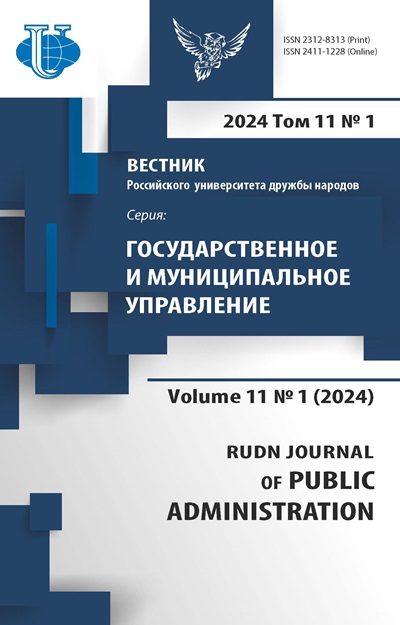The experience of studying the best practices of cluster development in Russia: the Kaluga Region
- Authors: Semenov SA1, Filatova OV2
-
Affiliations:
- The Russian Presidential Academy of National Economy and Public Administration
- Peoples’ Friendship University of Russia (RUDN University)
- Issue: Vol 4, No 4 (2017)
- Pages: 377-390
- Section: Management of development of territories
- URL: https://journals.rudn.ru/public-administration/article/view/18202
- DOI: https://doi.org/10.22363/2312-8313-2017-4-4-377-390
Cite item
Full Text
Abstract
The article analyzes the practice of cluster development of the Kaluga region. The authors study the main social and economic results of the investment and the ways of organization of cluster development management. The main mechanisms contributing to the positive results are identified. They are in creation of the infrastructure fields and the special way of building the system of management and of organization of the cluster development. One of the approaches to the organization of the system of management of the cluster development is the division of administrative and communicative functions and the functions of the financial management and of the infrastructure development. The article studies the organizational decisions for the realization of the principle of functional division and also shows one of the ways of the decision of the problem of coordination between the organizations included in the cluster.
About the authors
S A Semenov
The Russian Presidential Academy of National Economy and Public Administration
Author for correspondence.
Email: sas29120@gmail.com
-
82/1 Vernadsky av., Moscow, Russia, 119571O V Filatova
Peoples’ Friendship University of Russia (RUDN University)
Email: o.filatova87@gmail.com
-
6 Miklukho-Maklaya St., Moscow, Russia, 117198References
- Investicionnaya strategiya Kaluzhskoj oblasti // The Decree of the Government of the Kaluga region. 25.03.2013. № 150.
- Koncepciya deyatel’nosti otkrytogo akcionernogo obshchestva «Korporaciya razvitiya Kaluzhskoj oblasti» / The Decree of the Government of the Kaluga region № 70. 27.02.2008 «Ob odobrenii koncepcii deyatel›nosti akcionernogo obshchestva «Korporaciya razvitiya Kaluzhskoj oblasti». URL: http://www.invest.kaluga.ru/files/uploads/files/doc4.pdf.
- Al’yans kompetencij «Park aktivnyh molekul». Istorii uspekha. URL: http://pam-alliance. ru/index.php/success-stories/success-stories-mbf.
- Valovoj regional’nyj produkt po sub»ektam Rossijskoj Federacii v 1998–2014 gg. URL: www.gks.ru/free_doc/new_site/vvp/vrp98-14.xlsx.
- Investicii / Dannye territorial’nogo organa gosudarstvennoj statistiki po Kaluzhskoj oblasti. URL: http://kalugastat.gks.ru/wps/wcm/connect/rosstat_ts/kalugastat/ru/statistics/ enterprises/investment.
- Klasternaya politika: dostizhenie global’noj konkurentosposobnosti / V.L. Abashkin, S.V. Artemov, E.A. Islankina i dr.; Minehkonomrazvitiya Rossii, AO «RVK», NIU HSE. M. : NIU HSE, 2017. 324 s. 500 ehkz.
- Klasternaya politika. Koncentraciya potenciala dlya dostizheniya global’noj konkurentosposobnosti. Doklad MED RF. 2015 g.
- Konsolidirovannye byudzhety sub»ektov rossijskoj Federacii i byudzhetov territorial’nyh gosudarstvennyh vnebyudzhetnyh fondov. URL: http://www.roskazna.ru/ispolneniebyudzhetov/konsolidirovannye-byudzhety-subektov.
- Korporaciya razvitiya Kaluzhskoj oblasti. Obshchaya informaciya. URL: http://m.invest. kaluga.ru/about/general.
- Kostin I.V. Sistema privlecheniya investicij v ehkonomiku Kaluzhskoj oblasti // Ehkonomika, Statistika i Informatika, №3, 2013 g. S. 45–48. S. 45.
- Osnovnye pokazateli investicionnoj deyatel’nosti v Kaluzhskoj oblasti za period: 2006 – noyabr’ 2017 g. URL: http://admoblkaluga.ru/sub/econom/invest/investment_ performance.php.
- Regiony Rossii. Osnovnye harakteristiki sub»ektov Rossijskoj Federacii. 2016: Stat. sb. / Rosstat. M., 2016. 671 s.
- Regiony Rossii. Social’no-ehkonomicheskie pokazateli. 2017: Stat. sb. / Rosstat. M., 2017. 1402 s.
- Rukovodstvo po formirovaniyu klasterov – osnovnye napravleniya formirovaniya i upravleniya klasternymi iniciativami. Proekt CLOE: Vnutrievropejskaya svyaz’ klasterov. URL:www.clusterforum.org.
- Dezhina I.G. Tekhnologicheskie platformy i innovacionnye klastery: vmeste ili porozn’? M. : Izdatel’stvo Instituta Gajdara, 2013. 124 s.: il.
- Arnaud Largier, Sylvie Lartigue, Odile Soulard, Christine Tarquis. Clusters Mondiaux: regards croises sur la theorie et la realite des clusters. Identification et cartographie des principaux clusters internationaux. 2008.
- Larissa Talmon-Gross, Michal Miedzinski. European Cluster Observatory. Case Study. Framework conditions to support emerging industries in the area of healthcare. 2016.
- Larissa Talmon-Gross, Michal Miedzinski. European Cluster Observatory. Case Study. Framework conditions to support emerging industries in the area of circular economy. 2015.
- Lysann Muller, Thomas Lammer-Gamp, Gerd Meier zu Kocker, Thomas Alslev Christensen. Clusters are individuals. Vol. 2. 2012.
- Orjan Solvell, Goran Lindqvist, Christian Ketels. The Cluster Initiative Greenbook (2003).
- Thomas Andersson, Sylvia Schwaag-Serger, Jens Sorvik, Emily Wise Hansson. The Cluster Policies Whitebook (2004).
















